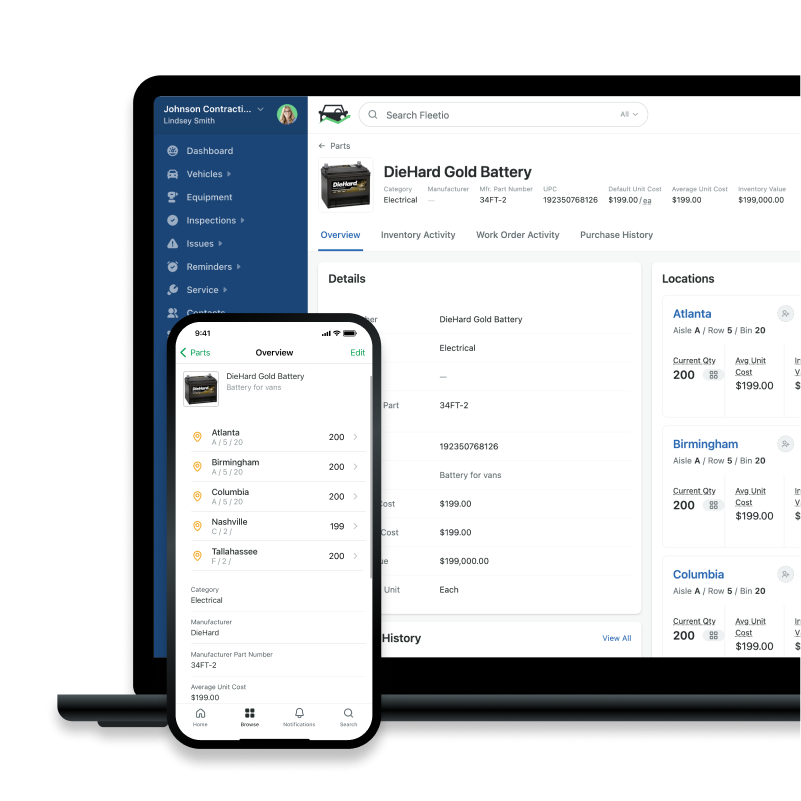Strategically Sourcing Parts During Price Uncertainty
Despite economist optimism and a slight reduction in inflation going into 2024, many things are still quite expensive, especially parts that are required to keep your fleet on the road. We’re looking at three avenues fleets can take for strategic parts procurement planning.
Jan 5, 2024
5 min read

The fleet industry — and the country — has seen some relief in the past couple months in the form of lower gas prices, a trend expected to continue in 2024, with Courier News projecting that “Memorial Day will be the priciest 2024 holiday at the pump, with the national average price of gasoline expected to be $3.56-$4.04 per gallon on the holiday.” On top of that, economists are optimistic that we’ll avoid a recession and see inflation start to decrease in 2024. Despite that double whammy of good news, automotive parts prices are still up and availability is spotty, part of which may be due to the UAW strike.
Unfortunately, parts procurement difficulties can negatively affect service workflows and cause unnecessary downtime.
Sometimes there’s delays [in servicing an asset] because we don’t always have the parts on hand, we have to order parts [or] sometimes it’s specialty. Everybody’s got something that’s backordered nowadays, so usually there’s a small delay with that. Michael Farr, Fleet Maintenance Manager, Wildfire Defense Systems
According to RevolutionParts, a company that helps automotive dealers maximize online OEM parts sales with eCommerce solutions: “The impact of global supply chain challenges is expected to continue throughout 2024 [...] In addition, labor shortages, particularly in the manufacturing sector, along with the rising cost of raw materials and freight due to inflation, are expected to continue to pose risks to supply chain management (SCM). These factors can lead to slower production, disrupted distribution, and delayed deliveries, impacting the timely availability of auto parts.”
To help your fleet prepare for shortages, delays and high prices, it’s important to explore several options, including stockpiling, running a lean inventory and a hybrid solution.
The Dilemma: Lean Inventory vs. Stockpiling
Let’s face it: stockpile is kind of an ugly word, but with current parts purchasing issues, fleets find themselves at a crossroads — to maintain a lean inventory or to stock up on parts, particularly those notorious for being on backorder. Each approach carries its own set of benefits, and the choice between them largely depends on the unique demands and characteristics of the fleet.
The Lean Inventory Approach: Cost-Efficiency Amidst Uncertainty
While a lean inventory approach may seem counterintuitive to ensuring parts availability, it actually offers unique benefits, especially for fleets who don’t mind aftermarket, refurbished or used parts.
Benefits
- Cost savings: Running a lean inventory minimizes upfront costs, providing short-term relief to budgets strained by inflation, and keeps inventory tracking easy, even when using a parts inventory spreadsheet.
- Adaptability: With a lean inventory, fleets can pivot quickly in response to changing vehicle technologies or model upgrades without holding excess, potentially obsolete, parts.
Strategy
- Real-time procurement: Fleets can leverage fleet management software (FMS) with inventory management systems to procure parts on an as-needed basis based on usage volume and low stock alerts.
- Strategic partnerships: Build strong relationships with reliable suppliers for quick and reliable parts procurement.
Ideal For
Fleets with rapidly changing vehicle models, or those newly adopting electric vehicles Fleets with limited budgets requiring immediate cost reduction
Stockpiling Parts: A Hedge Against Uncertain Supply Chains
Purchasing parts for fleet vehicles doesn’t need to be an excessively common task. Keeping inventory stocked even slightly above normal is a great way to keep your fleet up and running should an asset need unplanned maintenance.
Benefits
- Availability assurance: In times of supply chain disruptions, having a stockpile ensures a buffer against parts shortages.
- Budget predictability: Locking in parts prices and quantities offers budgetary predictability — even in times of inflation — and allows for proper inventory valuation.
Strategy
- Strategic forecasting: Analyze historical data and parts pricing trends to anticipate which parts might be prone to shortages.
- Supplier negotiations: Negotiate bulk deals or long-term contracts with suppliers to secure favorable pricing.
Ideal For
Fleets relying on assets with a history of backordered parts or requiring specialty parts Fleets with a larger budget
Don’t let Inflation Make You Flinch
Track and manage parts inventories, set auto-reordering and customize low stock alerts with inventory management in Fleetio.
Learn moreThe Middle Ground: A Hybrid Approach
Recognizing the benefits of both strategies, some fleets may opt for a middle ground. This involves maintaining a lean fleet parts inventory for commonly used — or easily, consistently available — parts while strategically stockpiling critical parts with a history of scarcity.
Benefits
- Balanced cost control: Achieve a balance between immediate cost control and long-term parts availability assurance.
- Adaptability and reliability: Combining the strengths of both approaches ensures fleets can adapt to change while having a safety net during supply chain disruptions.
Strategy
- Tiered inventory management: Classify parts into tiers based on criticality and availability, adopting the appropriate strategy for each tier.
- Continuous evaluation: Regularly reassess market conditions and adjust the inventory strategy accordingly.
Ideal For
Fleets with a moderate budget looking for a reasonable compromise with minimal risk Fleets with diverse assets and usage patterns
A Pragmatic Approach to Parts Procurement
Managing parts inventory effectively doesn’t have to be a burden. Fleets can use parts inventory software or FMS — like Fleetio! — to add a level of automation to inventory management, including custom auto-reorder thresholds and low stock alerts. Plus, if a technician attaches a part to a digital work order, the software will automatically adjust the inventory count. Fleets can also use the FMS’s native parts inventory app to quickly adjust counts or receive new stock, making inventory management… well, manageable.
The approach to procuring replacement parts demands a touch of pragmatism, and fleets must balance the immediate need for cost control with the imperative of ensuring the reliability of their assets. Whether it's the agility of a lean inventory, the assurance of a stockpile or the balance of a hybrid approach, the key lies in adaptability and continuous evaluation to ensure your fleet has what it needs to run optimally.
Unlock Your Inner Specialist
Inventory specialist, that is. Schedule a custom walkthrough to see how Fleetio can help you tap into your inner inventory guru.
Schedule it
Senior Fleet Content Specialist
As a Senior Fleet Content Specialist at Fleetio, Rachael Plant uses her near decade of industry experience to craft practical content aimed at helping fleet professionals tackle everyday challenges with confidence.
LinkedIn|View articles by Rachael PlantReady to get started?
Join thousands of satisfied customers using Fleetio
Questions? Call us at 1-800-975-5304

